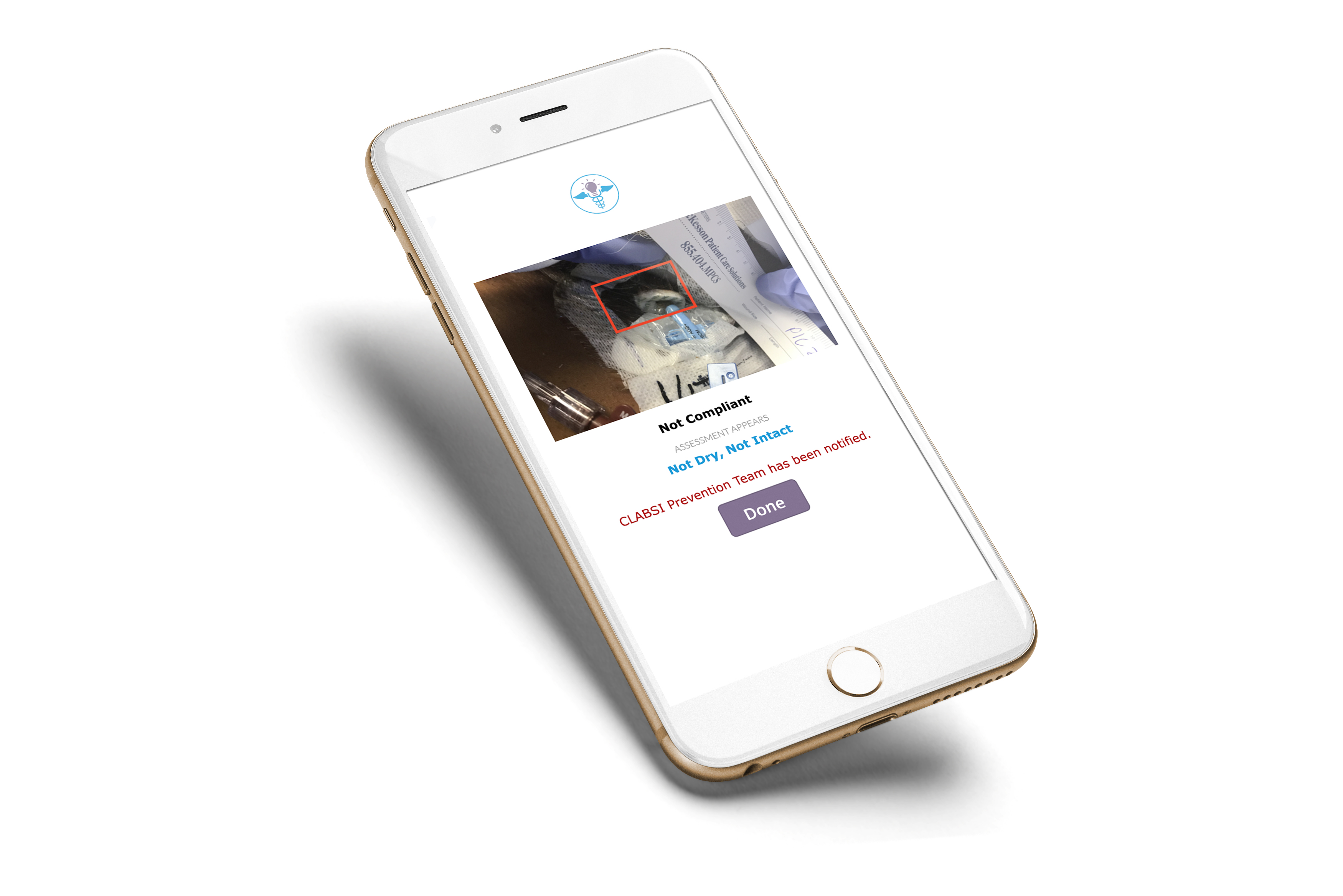7 min read
Novel Machine Vision Solution Proactively Informs Care Teams of Potential Central-Line Dressing Compliance Issues
By: Synaptiq Feb 2, 2022 5:38:00 PM

Synaptiq’s Demo Solution Leverages Artificial Intelligence to Improve Hospital Workflow & Training and Helps Mitigate Central Line Associated Bloodstream Infection (CLABSI) Risk
Abstract
In collaboration with Microsoft, Synaptiq built a first-of-its-kind artificial intelligence demo solution to proactively inform care teams of potential central-line dressing compliance issues. The solution is designed to improve hospital workflow, patient outcomes, speed of care, help reduce preventable deaths from hospital-borne infections (such as CLABSI), and help mitigate financial and reputation risk to hospitals.
Background: the CLABSI Problem
A central line (CL) is an intravenous tube typically placed to transfer blood, medication, or for other purposes that require venous access. Over 5 million central lines are placed annually in the United States, accounting for more than 15 million cumulative CL days*, every year.
CL placement is a common procedure with lifesaving applications. However, it is not risk-free. A central line associated bloodstream infection (CLABSI) occurs when bacteria or other harmful agents enter the bloodstream through a CL placement. According to a 2021 NIH publication, “the CLABSI rate in [American] intensive care units (ICU) is estimated to be 0.8 per 1,000 central line days.” 400,000 CLABSIs and 28,000 CLABSI-related deaths occur in the U.S. alone, every year.
* A “CL day” is a unit of time that measures how long a Central Line remains in a patient’s body.
CLABSI Cost Burden
CLABSIs are the most costly of all healthcare-associated infections. Each case generates an average cost-burden of $46,000, adding up to over $2 billion annually in the United States alone. Furthermore, it was reported in February 2022 that the Centers for Medicare and Medicaid Services (CMS) cut fiscal year 2022 funding to 764 hospital systems across the United States that had a high rate of preventable hospital-borne infections, including CLABSI.
At the patient level, a CLABSI (or even suspicion of one) necessitates removal of the infected CL. This correction prolongs the affected patient’s hospital stay and increases their risk of further complications.
Unfortunately, since immunocompromised, elderly, infant, and other high-risk patients are the most common victims of CLABSIs, these tragically widespread infections are most likely to endanger the health and financial security of the vulnerable individuals – who are the least prepared to combat them.
Dressings—special bandages applied to an open wound (e.g, a CL placement)—help prevent CLABSIs by keeping the insertion site sterile, dry, and protected from outside elements. However, CL dressings must be changed and monitored in compliance with rigorous CLABSI prevention guidelines as non-compliant dressings increase the risk of CLABSI development.
The Challenge: Ensuring CL Dressing Guideline Compliance
A 2015 survey of Intensive Care Unit (ICU) workers found that the majority—about 80 percent—had access to clinical guidelines for CLABSI prevention. However, only 23 percent of ICU workers in middle-income counties and 60 percent in high-income countries were found to be in compliance.
.png?width=400&name=TYPE%20(3).png)
.png?width=400&name=TYPE%20(2).png)
Healthcare institutions (e.g., hospitals) understand the importance of CL dressing guideline compliance—but they face significant challenges in ensuring it. First, it is difficult for large healthcare institutions to confirm that all staff are educated and in compliance, especially across departments. Other complicating factors include the high volume of CL placements performed and natural variation in CLABSI clinical manifestation.
Ultimately, CL dressing guideline compliance challenges are rooted in a shortage of human resources. Today more than ever, with COVID-19 exhausting healthcare systems worldwide, the limiting reactant in CLABSI prevention is a deficit of time and energy to keep up-to-date and in compliance with rigorous guidelines across a huge number of patients.
Collaboration with Microsoft
Synaptiq recently collaborated with Microsoft and healthcare providers to create a novel demo solution for helping to ensure CL dressing guideline compliance. The concept includes a model to be trained once data is collected. For this demo solution, healthcare workers check CL dressings for CLABSI-linked non-compliance issues in three steps:
- A member of “Patient X ’s” care team uses the Synaptiq solution’s easily accessible, user-friendly mobile app to submit an image of Patient X’s CL dressing.
- The solution uses machine vision (a type of AI specialized to process visual data) to determine whether the dressing is out of compliance (e.g., wet, discolored, not intact).
- The solution alerts Patient X’s care team if there are indicators of non-compliance.
This solution would not only help healthcare workers check CL dressings for compliance issues that may result in CLABSI, it could also detect issues imperceptible to the human eye (e.g., minor discoloration). It would not replace human staff – but, rather, dramatically enhance their abilities to monitor their patients and take action quickly when a possible dressing compliance issue arises.
Inquire About Pilot Program Participation
Machine Vision: A Primer
Machine vision is a type of artificial intelligence (AI) that enables computers to derive information from visual inputs. It works analogously to human vision.
When human beings “see” an object, three things must occur.
- First, our eyes take in light reflected off the object, which cells called photoreceptors convert into electrical signals;
- Second, these signals travel from our eyes through the optic nerve to our brain; and
- Third, our brain converts these signals into what we “see” in our mind’s eye.
Similarly, machine vision uses machine “eyes” (e.g., a camera) to intake visual data, which a machine “brain” (e.g., a computer system) then analyzes and converts into useful information. Effectively, machine vision gives humans “sight beyond sight” – with the ability to see, process, and provide outputs – faster than they ever could without computer aid.
Although computer and human vision work similarly, computers have two huge advantages: precision and power. Human eyes are fallible; that is why we rely on technology like microscopes to enhance sight. Computers have no such limitation.
Thus, computer vision is able to collect more precise visual data than human vision ever could – and uses processing power to analyze it faster and more thoroughly than the human mind.
The Synaptiq demo solution combines the advantages of computer vision with those of human judgment. We recognize that human healthcare workers are best-suited to give diagnosis and assign treatments. Our demo solution grants workers the best information to make these decisions – as quickly and with as much precision as possible.

Demo Solution Overview
The AI-powered demo CLABSI solution, developed in collaboration with Microsoft, helps care teams identify potential dressing compliance issues and alerts them to investigate. It leverages many Microsoft technologies that are already owned by most major hospital systems in the United States.
There are three applications that are part of the solution that support this process:
- CLABSI assessment app (Microsoft PowerApp)
- CLABSI team (Microsoft Teams)
- CLABSI dashboard (Microsoft PowerBI)
The CLABSI assessment app runs on a smartphone and is used to capture and analyze photos of patients’ dressings. If a potential compliance issue is identified, the CLABSI team is alerted to take action. Over time, data from the provider’s electronic medical system accumulates information from the CLABSI assessment app and the patients’ medical record and our CLABSI dashboard provides a series of canned reports and ad hoc reporting capabilities to analyze CLABSI trends.
It is a unique opportunity for innovative, large hospitals to implement this new solution on their Microsoft Azure account and utilize it with a controlled group of care teams over a period of 3-6 months.
The desired outcome of this Pilot Program is to develop a complete solution that helps hospitals do a better job training and monitoring central line dressings and mitigate overall risk. For more information on this project, a demo video, or requirements to join, please visit the Synaptiq website's CLASBI Pilot Program page and submit your contact and hospital information for review and consideration.
References
Haddadin, Y., Annamaraju, P., & Regunath, H. (2021). Central Line Associated Blood Stream
Infections. StatPearls
Bell, T., & O’Grady, N. (2017). Prevention of Central Line-Associated Bloodstream Infections.
Infectious Disease Clinics of North America, 31(3), 551–559.
https://doi.org/10.1016/j.idc.2017.05.007
Elcam Safety. (2017). CLABSI Prevention Challenges.
https://www.infusesafety.com/challenges-in-clabsi-prevention
Agency for Healthcare Research and Quality. (2018). Guidelines to Prevent Central
Line-Associated Blood Stream Infections.
https://www.ahrq.gov/hai/clabsi-tools/appendix-3.html
Mianecki, T., & Peterson, E. (2021). The Relationship Between Central Line-Associated
Bloodstream Infections and Extended Intravenous Solution Hang Times. The Art and
Science of Infusion Nursing, 44(3), 157–161.
https://doi.org/10.1097/NAN.0000000000000425
Parreco, J., et al. (2018). Predicting central line-associated bloodstream infections and mortality
using supervised machine learning. Journal of Critical Care, 45, 156–162.
https://doi.org/10.1016/j.jcrc.2018.02.010










